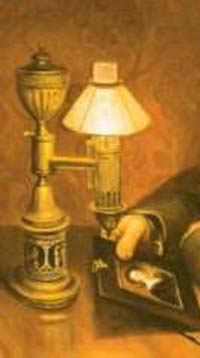|
|
 The
Argand lamp was invented by Aimé Argand a Swiss chemist .in
1780, it was a great improvement on other forms of lighting available
at the time. Essentially it consisted of a circular wick mounted
between two circular metal tubes, these tubes allowed a current
of air to the inside of the wick as well as the outside, a cylindrical
glass tube or globe increased the draught and maintained a steady
flame. The lamp produced the equivalent of 6 to 10 candles, it burnt
a good quality liquid oil, such as spermaceti whale oil, the lamp
quickly found favour firstly among the rich but its popularity quickly
spread to all classes. The
Argand lamp was invented by Aimé Argand a Swiss chemist .in
1780, it was a great improvement on other forms of lighting available
at the time. Essentially it consisted of a circular wick mounted
between two circular metal tubes, these tubes allowed a current
of air to the inside of the wick as well as the outside, a cylindrical
glass tube or globe increased the draught and maintained a steady
flame. The lamp produced the equivalent of 6 to 10 candles, it burnt
a good quality liquid oil, such as spermaceti whale oil, the lamp
quickly found favour firstly among the rich but its popularity quickly
spread to all classes.
During the late 17 early 1800's lighthouse
building was in its ascendancy Argand's lamp were ideal in this
situation, in 1810, 27 Argand lamps were installed in the light
on Lighthouse Island
one of the Copeland Islands off the County Down coast, this happened
all over the British Isles and Ireland and no doubt the continent
also.
When paraffin oil became available many of
the lamps were converted to run on it, like all good ideas Argand's
was copied by Frenchman, named Quinquet, lamps became known as "Quinquet's"
in France.
|